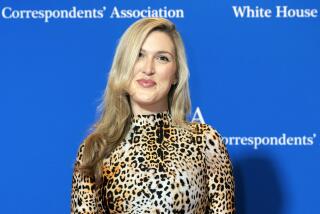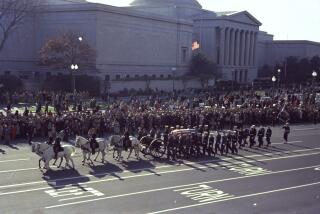George Rebounds After JFK Jr.’s Death
- Share via
Remember this name: Frank Lalli. He’s going to make the world forget John F. Kennedy Jr.
Well, maybe not. JFK Jr. was a public figure--the slain president’s son, handsome man, founder of George magazine, victim of a plane crash. Lalli is none of those things. He’s merely the editor who transformed George into a good magazine.
George was born five years ago in a frenzy of Kennedy-induced hype. It was a magazine about politics with a decidedly pop sensibility symbolized by the first cover, which showed supermodel Cindy Crawford dressed like George Washington--or at least as Washington would have dressed if he had left his army uniform unbuttoned to expose his washboard abs.
In that issue, Kennedy promised a “post-partisan” magazine that would define politics broadly--”from elected officials to media moguls to movie stars to ordinary citizens”--and cover it “exuberantly.”
It was a good idea, but under Kennedy’s reign the execution was spotty. There were lots of splashy graphics and plenty of movie stars but not, alas, much depth.
George seemed to be pandering to the public but the public wasn’t buying. By the summer of 1999, there were rumors that George’s parent company, Hachette Filipacchi, was about to pull the plug. When Kennedy died that July, the magazine world figured George was doomed.
It wasn’t. This year, under Lalli’s editorship, George is thriving.
“Circulation has increased 25% to more than 500,000,” Lalli reported in a recent issue, and ad sales are also rising. The reason for this turnaround is simple and kind of inspiring: The magazine is a lot better than it used to be.
The basic formula is the same. George is still a pop magazine with glitzy graphics and top-10 lists and plenty of movie stars. Crawford reappeared on the cover in September, snuggling with her husband to tout a ditzy story on how celebrity couples handle their political differences.
This issue also features stories revealing the political philosophies of Danny Glover, Bo Derek and Shannen Doherty.
George runs so many stories about celebrities and their heartfelt political passions that you begin to wonder how movie stars ever find the time to do their work, much less indulge in such traditional Hollywood hobbies as philandering, substance abuse and punching tabloid photographers.
But Lalli has added something rarely found in the Kennedy years: solid, well-reported, well-written stories, many of them bringing a much-needed historical perspective to today’s political controversies.
For instance, last spring, when the Confederate flag was a hot issue, George ran a piece by Pulitzer Prize-winning historian David Garrow. He proved that the Rebel flag had little to do with “tradition”--it was rarely displayed in the South between Appomattox and World War II--and much to do with white backlash against civil rights.
And last April, George marked the 25th anniversary of the fall of Saigon with a piece by another Pulitzer winner, David Halberstam, that was the best short explanation of the Vietnam debacle that I’ve ever read. It should be stapled to the back of every high school history textbook in America.
The September issue had several good pieces and an extraordinary one. The good pieces included Aaron Latham’s look at George W. Bush’s religious views--”I believe God wants me to run for President,” W says at one point--and Jesse Ventura’s surprisingly thoughtful view of the presidential candidates. The extraordinary story is “Greetings From Death Town, U.S.A,” Stephen Rodrick’s portrait of Huntsville, Texas, where 40% of America’s executions have taken place since 1995.
Rodrick’s piece is no knee-jerk, anti-death-penalty polemic. It’s a nuanced, impressionistic and darkly comic look at a town whose economy and culture are based on imprisoning and killing felons. He interviews the warden--who proudly points out the prison flower gardens--and the chaplain, a genuinely dedicated man who collects the autographs of the soon-to-be-executed in his Bible.
Rodrick also visits the prison graveyard--which was landscaped and beautified by the man who once held the job of executioner--and the local Texas Prison Museum, which displays, among other “jaw-dropping artifacts,” a boot once used to hide the drug stash of murderer Charles Harrelson, father of actor Woody Harrelson.
In the end, Rodrick interviews a condemned killer and then watches his execution, only to find that his reaction to the event is surprising even to himself.
This is a great story and Rodrick is a very good writer. Remember his name. He’s going to make the world forget William Shakespeare.
Well, probably not. But you get the idea.
More to Read
The biggest entertainment stories
Get our big stories about Hollywood, film, television, music, arts, culture and more right in your inbox as soon as they publish.
You may occasionally receive promotional content from the Los Angeles Times.










